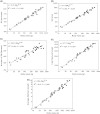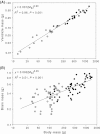Variable extent of parallelism in respiratory, circulatory, and neurological traits across lake whitefish species pairs
- PMID: 23532362
- PMCID: PMC3605845
- DOI: 10.1002/ece3.469
Variable extent of parallelism in respiratory, circulatory, and neurological traits across lake whitefish species pairs
Abstract
Parallel adaptive radiation events provide a powerful framework for investigations of ecology's contribution to phenotypic diversification. Ecologically driven divergence has been invoked to explain the repeated evolution of sympatric dwarf and normal lake whitefish (Coregonus clupeaformis) species in multiple lakes in eastern North America. Nevertheless, links between most putatively adaptive traits and ecological variation remain poorly defined within and among whitefish species pairs. Here, we examine four species pairs for variation in gill, heart, and brain size; three traits predicted to show strong phenotypic responses to ecological divergence. In each of the species pairs, normals exhibited larger body size standardized gills compared to dwarfs - a pattern that is suggestive of a common ecological driver of gill size divergence. Within lakes, the seasonal hypoxia experienced in the benthic environment is a likely factor leading to the requirement for larger gills in normals. Interestingly, the morphological pathways used to achieve larger gills varied between species pairs from Québec and Maine, which may imply subtle non-parallelism in gill size divergence related to differences in genetic background. There was also a non-significant trend toward larger hearts in dwarfs, the more active species of the two, whereas brain size varied exclusively among the lake populations. Taken together, our results suggest that the diversification of whitefish has been driven by parallel and non-parallel ecological conditions across lakes. Furthermore, the phenotypic response to ecological variation may depend on genetic background of each population.
Keywords: Adaptive radiation; Coregonus clupeaformis; brain; ecology; gill; heart ventricle; morphological divergence; speciation.
Figures






Similar articles
-
Parallelism in the oxygen transport system of the lake whitefish: the role of physiological divergence in ecological speciation.Mol Ecol. 2012 Aug;21(16):4038-50. doi: 10.1111/j.1365-294X.2012.05682.x. Epub 2012 Jun 25. Mol Ecol. 2012. PMID: 22724454
-
The genetic architecture of ecological speciation and the association with signatures of selection in natural lake whitefish (Coregonus sp. Salmonidae) species pairs.Mol Biol Evol. 2007 Jun;24(6):1423-38. doi: 10.1093/molbev/msm066. Epub 2007 Apr 2. Mol Biol Evol. 2007. PMID: 17404398
-
Modeling the Multiple Facets of Speciation-with-Gene-Flow toward Inferring the Divergence History of Lake Whitefish Species Pairs (Coregonus clupeaformis).Genome Biol Evol. 2017 Aug 1;9(8):2057-2074. doi: 10.1093/gbe/evx150. Genome Biol Evol. 2017. PMID: 28903535 Free PMC article.
-
SNP signatures of selection on standing genetic variation and their association with adaptive phenotypes along gradients of ecological speciation in lake whitefish species pairs (Coregonus spp.).Mol Ecol. 2011 Feb;20(3):545-59. doi: 10.1111/j.1365-294X.2010.04952.x. Epub 2010 Dec 9. Mol Ecol. 2011. PMID: 21143332
-
Local variation and parallel evolution: morphological and genetic diversity across a species complex of neotropical crater lake cichlid fishes.Philos Trans R Soc Lond B Biol Sci. 2010 Jun 12;365(1547):1763-82. doi: 10.1098/rstb.2009.0271. Philos Trans R Soc Lond B Biol Sci. 2010. PMID: 20439280 Free PMC article. Review.
Cited by
-
RAD-QTL Mapping Reveals Both Genome-Level Parallelism and Different Genetic Architecture Underlying the Evolution of Body Shape in Lake Whitefish (Coregonus clupeaformis) Species Pairs.G3 (Bethesda). 2015 May 21;5(7):1481-91. doi: 10.1534/g3.115.019067. G3 (Bethesda). 2015. PMID: 26002924 Free PMC article.
-
Evolution of Plasticity in Brain Morphology.Brain Behav Evol. 2025;100(3):209-218. doi: 10.1159/000544711. Epub 2025 Feb 13. Brain Behav Evol. 2025. PMID: 39947167 Free PMC article. Review.
-
Differences in brain transcriptomes of closely related Baikal coregonid species.Biomed Res Int. 2014;2014:857329. doi: 10.1155/2014/857329. Epub 2014 Jan 29. Biomed Res Int. 2014. PMID: 24719892 Free PMC article.
-
Differences among families in craniofacial shape at early life-stages of Arctic charr (Salvelinus alpinus).BMC Dev Biol. 2020 Oct 26;20(1):21. doi: 10.1186/s12861-020-00226-0. BMC Dev Biol. 2020. PMID: 33106153 Free PMC article.
-
Evolutionary ecology of intraspecific brain size variation: a review.Ecol Evol. 2013 Aug;3(8):2751-64. doi: 10.1002/ece3.627. Epub 2013 Jun 26. Ecol Evol. 2013. PMID: 24567837 Free PMC article.
References
-
- Bauchot R, Bauchot ML, Platel R, Ridet JM. Brains of hawaiian tropical fishes – brain size and evolution. Copeia. 1977;1:42–46.
-
- Bauchot R, Randall JE, Ridet JM, Bauchot ML. Encephalization in tropical teleost fishes and comparison with their mode of life. J. Hirnforsch. 1989;30:645–669. - PubMed
-
- Bernal D, Dickson KA, Shadwick RE, Graham JB. Review: analysis of the evolutionary convergence for high performance swimming in lamnid sharks and tunas. Comp. Biochem. Physiol. A Mol. Integr. Physiol. 2001;129:695–726. - PubMed
-
- Bernatchez L. Ecological theory of adaptive radiation – an empirical assessment from Coregonine fishes (Salmoniformes) In: Hendry AP, Stearns SC, editors. Evolution illuminated: salmon and their relatives. New York, NY: Oxford Univ. Press; 2004. pp. 175–207.
LinkOut - more resources
Full Text Sources
Other Literature Sources

